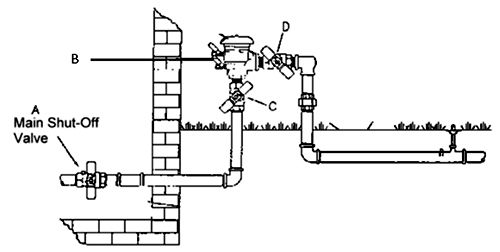Sprinkler System Winterization#
Learn to avoid costly repairs by winterizing your sprinkler system:
- Detach hoses from outdoor spigots and store them inside to prolong their lifespan.
- Call a water-wise professional to schedule your winterization. Typically, compressed air is used to force water out of the in-ground irrigation equipment. (Utilities recommends working with a licensed irrigation contractor for winterization).
Tip: Don't unplug your controller. Instead, use the “off” function so you don’t lose your irrigation program(s) and schedule. If you plan to unplug your controller, write down your schedule for next year.
Q. We are getting our first freeze of the season and I haven’t winterized. Will my equipment be damaged?
A. Soil temperatures don’t drop as rapidly as air temperatures. If a freeze comes before you winterize, focus on above-ground equipment.
- Shut off your sprinkler system’s water supply (A)--most likely located in your basement.
- Drain excess water from the supply line into a bucket.
- Next, go to your backflow device and open the test cocks (B) with a flat screwdriver to release any trapped water.
- After the water stops flowing, turn all the valves--test cocks and ball valves (C and D)--on the backflow to a 45-degree angle (as shown in diagram). This gives any remaining water somewhere to go, instead of freezing between the fittings.
- Run a test cycle on your controller. You should not see any water come out of the sprinkler heads since the supply water has been shut off.
- Remove hoses from outdoor spigots.
This will help protect your equipment for the first cold snap. Remember to call a professional to blow the remaining water out of the underground lines.
Q. What happens if I don’t winterize?
A. Water that remains in your backflow and underground lines will freeze. Frozen water expands, leaving you with broken pipes and equipment. Leaky sprinkler systems mean costly repairs, high water bills and more.
Q. I see a very small drip coming from one of the in-ground sprinkler valves. Is it worth the trouble to fix?
A. Yes. Even small drips waste thousands of gallons per month. Gallons saved equals money in your pocket.
-
Cool nighttime temperatures mean plants need less water. In fact, recommended watering frequency during early fall is only one day per week.
If you don't want to eliminate days from your watering schedule, use your controller’s ‘water budget’ or ‘seasonal adjustment’ feature to reduce run times without reprogramming each zone.
- At the height of the watering season (typically July), your ‘seasonal adjustment,’ program should be at 100 percent. During the fall months, your seasonal adjustment setting should be between 50-80 percent, depending on the weather.
- As temperatures increase or decrease, use this function to water more, or less, accordingly. For example, if a zone is set to water for 20 minutes, and the seasonal adjustment is changed from 100 percent to 50 percent, the zone will now water for 10 minutes.
Did You Know?
Pre-heating your home before 5 p.m. in the winter and coasting through the on-peak hours can save money on your utility bill.
Sprinkler systems can be designed, installed and operated with water-efficiency in mind.
Oil and other toxic vehicle fluids end up in puddles where our kids and pets like to play. Don't drip and drive.
